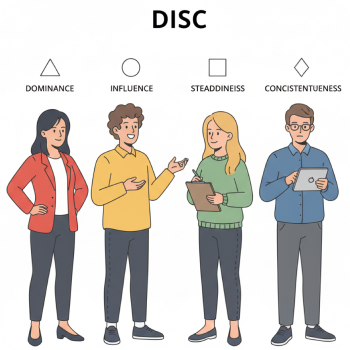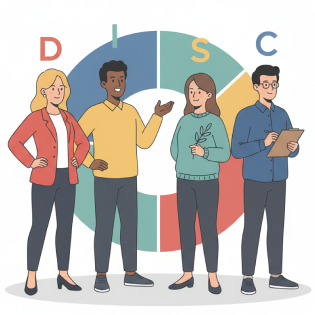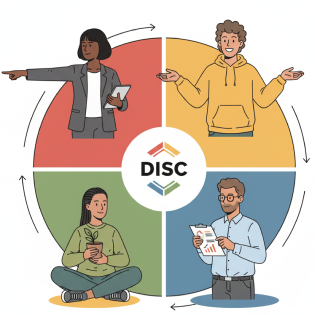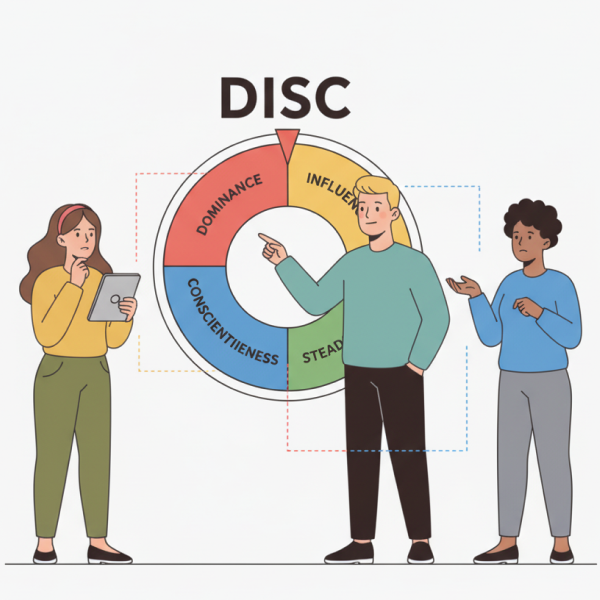The Value of DISC in Understanding Behavior
Many readers want a clear rationale for using a practical instrument before they adopt it. Professionals frequently rely on the DISC personality assessment to establish a shared baseline for conversations about style, expectations, and preferred methods of feedback in teams. By framing behavior through observable patterns, it reduces friction and accelerates rapport. Clarity grows when we separate transient moods from repeatable behavioral cues. Organizations also appreciate that the DISC personality model is straightforward to explain to busy managers and individual contributors, which speeds adoption.

DISC Test Explained Simply
The underlying acronym has a long research lineage and still sparks curiosity today. Many newcomers ask the practical question, including what does DISC stand for in personality test, because decoding each letter simplifies how they interpret personal reports and team dashboards. Knowing the four letters makes it easier to connect patterns with real-world behaviors during meetings and projects.
Start the Test-
![]() Use structured agendas that balance speed and detail.
Use structured agendas that balance speed and detail. -
![]() Alternate between synchronous and asynchronous updates.
Alternate between synchronous and asynchronous updates. -
![]() Define decision thresholds and escalation paths in advance.
Define decision thresholds and escalation paths in advance.
How 4 Personality Styles Test Operate in Practice
Leaders often begin by mapping conversation habits and decision rhythms, then translate those insights into project rituals. Coaches commonly use DISC personality profiling when introducing a behavior-first lens that avoids labels and keeps the focus on specific actions that can be adapted. This keeps development tangible and measurable across sprints or quarters. Once the core tendencies are visible, teams can build shared playbooks. Facilitators sometimes work with a concise matrix like the DISC model personality test to show how intensity levels shift across low-pressure and high-stakes scenarios for each of the four letters. This gives everyone a fast, memorable snapshot to reference during planning and retrospectives.
| Style | Core Drivers | Communication Tips | Potential Blind Spots |
|---|---|---|---|
| Dominance (D) | Results, autonomy, speed | Be brief, focus on outcomes, offer options | Impatience, overlooking details, over-assertion |
| Influence (I) | Connection, optimism, recognition | Be energetic, tell stories, invite collaboration | Follow-through gaps, distraction, and overpromising |
| Steadiness (S) | Stability, harmony, reliability | Provide context, be supportive, allow time | Resistance to rapid change, conflict avoidance |
| Conscientiousness (C) | Accuracy, logic, structure | Share data, explain criteria, clarify expectations | Overanalysis, perfectionism, slow decisions |
As groups build shared rituals, they reduce misalignment and gain predictable rhythms. Many practitioners keep a concise summary of their DISC personality profile handy, which acts like a user manual for colleagues during handoffs, standups, and reviews. This practice normalizes style differences and fosters psychological safety around feedback.
Use the DISC Personality Assessment to Drive Engagement
Learning functions notice faster adoption when workshops are practical and scenario-based. Teams looking for a skills-first approach to communication often pair coaching with DISC training personality to help participants practice specific micro-behaviors that improve clarity and reduce rework. Small, repeatable changes compound into major performance improvements over time.

Managers also report stronger engagement when each contributor’s strengths are visible and respected. HR partners may document changes using a structured DISC personality profile assessment to clarify growth plans, succession options, and peer mentoring matches that accelerate development. This shared visibility keeps momentum high and reduces the costs of turnover.
-
![]() Shorter feedback loops and clearer expectations.
Shorter feedback loops and clearer expectations. -
![]() Higher trust through transparent communication norms.
Higher trust through transparent communication norms. -
![]() Better handoffs across functions and time zones.
Better handoffs across functions and time zones.
Take DISC Personality Assessment Online
Get Started-
![]() Leadership standups that balance brevity and detail.
Leadership standups that balance brevity and detail. -
![]() Sales scripts that adjust tone and structure by audience.
Sales scripts that adjust tone and structure by audience. -
![]() Hiring loops that assess behavioral flexibility with scenarios.
Hiring loops that assess behavioral flexibility with scenarios.

Facilitators often kick off a debrief by clarifying language and assumptions, then comparing self-perception with observed behaviors. Participants frequently ask about the meaning of DISC personality test, and that conversation lays the groundwork for connecting report language to specific scenarios like brainstorming, planning, and escalation. Project leads may introduce a structured worksheet built around a DISC personality assessment tool so individuals can identify triggers, preferred communication channels, and recovery strategies after stressful interactions. Some groups run a short challenge modeled like a personality style quiz, which makes review sessions lively.
Start the TestSelecting a Valid DISC Assessment Personality Test
Selecting a valid instrument reduces noise and prevents misinterpretation. Look for providers that explain methodology, offer clear reliability data, and provide coach guidance for debriefs. Ethical guidelines should cover privacy, storage, and consent, with a clear separation between development use and high-stakes employment decisions. When comparing options, practitioners typically evaluate clarity, actionability, and cost. HR teams sometimes pilot a cohort using a vetted DISC assessment personality test to confirm that insights map to real behavior changes in meetings, sales calls, and customer support. A small trial helps leaders refine rollout plans and debrief structures before scaling across departments.

Language also matters when communicating intent and scope with participants. Some organizations rely on a simple explainer that references the DISC test personality in plain terms, ensuring the focus stays on growth, teamwork, and communication hygiene rather than on labeling. This framing builds trust and prevents misuse of the data in performance judgments.

DISC Test for Development
Entry points vary by organization and maturity stage, and pilots can be low-cost. Some teams begin with a lightweight screener similar to a DISC personality test free option to spark interest, then move to a more robust solution for ongoing development and coaching. This phased approach meets people where they are and maintains momentum.
Start the TestConclusion
As momentum grows, leaders formalize rituals and embed style-aware templates in playbooks. Global groups sometimes share a quick-reference guide that mentions a DISC personality test free to download in onboarding materials to give new hires a head start on vocabulary and self-reflection. In fast-growing environments, that early orientation reduces friction and accelerates integration.
Frequently Asked Questions
- Is DISC a measure of skill or intelligence?Neither. DISC describes observable behavior and communication preferences, not capability or cognitive ability. It helps teams understand how someone tends to approach tasks, collaboration, and decision-making.
- Can my style change over time?Yes, especially with new roles, coaching, or environment shifts. People also adapt style situationally, showing different behaviors under pressure versus routine conditions.
- Should managers use results for hiring decisions?Use results to inform communication and onboarding, not to exclude candidates. Ethical practice keeps assessments for development and culture fit conversations, not as a gate for employment.
- How long does a typical assessment take?Most instruments take 10–20 minutes, followed by a debrief to translate insights into concrete behaviors that improve teamwork and outcomes.
- What’s the best way to roll out DISC to a large team?Start with a pilot, train facilitators, create simple templates, and schedule debriefs linked to real workflows. Follow up with short refreshers and behavior-focused retros.
The Latest News
 Discover Your Behavioral Style: Understanding DISC for Personal Growth Take DISC Personality Assessment Online Get Started What Is DISC and Why Does It Matter People communicate, decide, and respond under pressure in predictably different ways, and the DISC framework offers a practical lens for making sense of those patterns. Rather than boxing anyone...
Discover Your Behavioral Style: Understanding DISC for Personal Growth Take DISC Personality Assessment Online Get Started What Is DISC and Why Does It Matter People communicate, decide, and respond under pressure in predictably different ways, and the DISC framework offers a practical lens for making sense of those patterns. Rather than boxing anyone... - 30 October, 2025
- The Ultimate Guide to Discovering Your DISC Style for Free Take DISC Personality Assessment Online Get Started What DISC Measures and Why It Matters Understanding how you prefer to communicate, decide, and collaborate can change the way you work and live. The DISC model maps observable behavioral tendencies across Dominance, Influence, Stea...
- 29 October, 2025
- DISC Personality: A Complete Guide to Styles, Benefits, and Practical Application Take DISC Personality Assessment Online Get Started Understanding the DISC Model: Origins and Core Principles People don’t wake up one day with a new temperament, yet they do adjust how they communicate, decide, and collaborate depending on context. That is why the DISC framew...
- 28 October, 2025
Please Note
This website (the-disc-personality-test.com) is not an official representative, creator or developer of this application, or product. All the copyrighted materials belong to their respective owners. All the content on this website is used for educational and informative purposes only.


